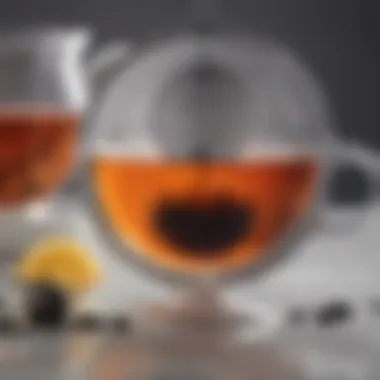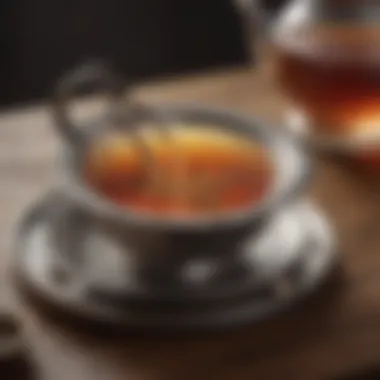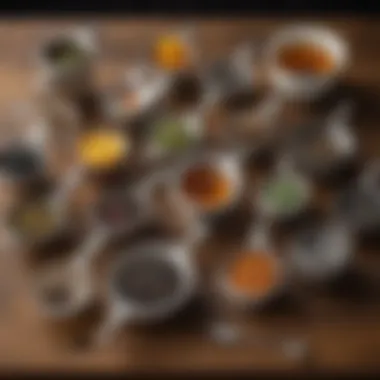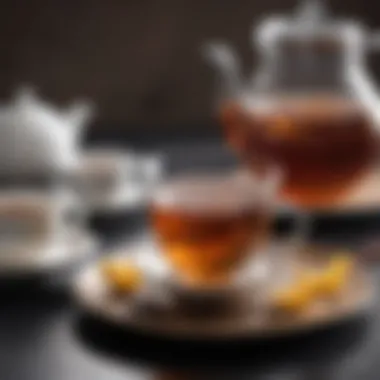Exploring the English Tea Strainer with Drip Cup


Intro
The English tea strainer with drip cup is more than just an accessory; it is a bridge between tradition and modern tea brewing practices. This tool plays a pivotal role in the art of tea preparation, assisting tea enthusiasts in creating a perfect cup every time. Understanding its significance requires an exploration of its design, functionality, and history.
The tea strainer is designed to separate the tea leaves from the brewed tea. Its drip cup collects any residual liquid, ensuring that no drops escape unnoticed. This combination not only enhances the tea experience but also adds a layer of finesse to the ritual of tea drinking.
Historically, tea brewing has evolved tremendously. The introduction of tea in England brought with it various customs and tools. Strainers emerged as a necessity, allowing for purity in flavor while avoiding the unpleasantness of floating tea leaves.
This article will not just skim the surface. Instead, it will dive deep into the various types of tea strainers available, their distinctive benefits, proper maintenance methods, and their cultural significance. By understanding these facets, readers will learn to select the ideal strainer for their needs, allowing them to enrich their tea-drinking experience.
Intro to English Tea Strainers
The English tea strainer, particularly one equipped with a drip cup, serves a crucial role in the tea brewing experience. For tea aficionados and casual drinkers alike, understanding this accessory can greatly enhance the appreciation for what makes tea truly enjoyable. This introduction will outline significant elements and benefits that arise from incorporating a tea strainer with a drip cup into your brewing routine.
Historical Overview
The history of tea strainers in England can be traced back several centuries. The rise of tea drinking in the 17th century coincided with the development of various accessories to enhance the tea-drinking experience. Initially, tea leaves were often brewed loose in a pot, leading to sediment that some found undesirable. Thus, the tea strainer emerged as a practical solution. The design evolved, taking into account not just functionality but also aesthetic appeal, resulting in an array of styles. The drip cup function is a more modern adaptation that addresses the age-old issue of spillage while waiting for the strainer to drain.
Purpose and Functionality
The primary purpose of an English tea strainer is to separate tea leaves from the brewed liquid. As hot water interacts with the leaves, steeping releases flavor and aromas, but it also creates residue that can affect the final cup. Strainers, therefore, ensure that only the smooth liquid is poured into your cup.
The integration of a drip cup is a valuable feature. It catches any remaining liquid that may linger in the strainer, preventing mess on your table or counter. This simple addition enhances usability, making the process more efficient. For those who value cleanliness alongside taste, a tea strainer with a drip cup is essential. In addition, the design often allows for ease of use with various types of teapots and mugs, making it a versatile choice in diverse tea-drinking settings.
In sum, English tea strainers not only reflect a historical evolution of craft but also fulfill essential roles in modern tea culture. They are a blend of practicality and tradition, appealing to both the discerning connoisseur and everyday tea drinkers. Understanding their history and purpose is the first step towards appreciating their significance in the world of tea.
Design Elements of the English Tea Strainer
The design elements of the English tea strainer play a crucial role in its effectiveness and functionality. These components not only reflect the aesthetic appeal but also enhance the brewing experience. Understanding these elements can guide tea lovers in selecting the right strainer and appreciating its value during tea preparation.
Material Considerations
The materials used to construct tea strainers significantly affect their performance and longevity. Common materials include stainless steel, which is favored for its durability and resistance to rust. On the other hand, fine mesh strainers often utilize nylon or silicone due to their flexibility and ease of cleaning.
Ceramic or porcelain strainers are also popular, adding a touch of elegance. However, these materials may be fragile. Selecting a material requires balancing aesthetics with functionality. A quality strainer made from suitable materials can last for years, making it a worthwhile investment for tea enthusiasts.
Shape and Structure
The shape and structure of a tea strainer influence how effectively it performs its function. A well-designed strainer should catch tea leaves while allowing liquid to flow freely. Most strainers feature a concave shape that fits snugly over a cup or teapot. This design minimizes spillage and enhances control during pouring.
The mesh quality is equally important. A finer mesh captures even the smallest particles, ensuring a smooth brew. Some strainers are equipped with handles or hooks, allowing for easy placement and removal. Overall, the design must ensure usability and efficiency in the tea-making process.
Drip Cup Mechanism
The drip cup mechanism is a distinctive feature of the English tea strainer, serving a functional purpose. After straining, the tea leaves can retain water, leading to unwanted mess. The drip cup captures this excess liquid, preventing spills on surfaces.
This design element also aids in presentation. Aesthetically, the drip cup complements the strainer, creating a cohesive look on the tea table. Many strainers with drip cups are also designed for easy cleaning, with removable components that simplify the maintenance process.


"The thoughtful design of the tea strainer, including the materials and mechanisms, elevates the tea brewing experience, reflecting both tradition and innovation."
Types of English Tea Strainers with Drip Cups
Understanding the various types of English tea strainers with drip cups is essential for anyone serious about tea brewing. Each type has unique attributes that cater to different preferences and styles of tea preparation. Furthermore, recognizing the distinctions helps in choosing the right accessory for enhancing your tea experience. Here, we will explore traditional strainers, modern variants, and innovative designs, each serving specific functions while contributing to the overall quality of the tea.
Traditional Strainers
Traditional tea strainers have a classic design that resonates with tea enthusiasts who appreciate timeless elegance. Often crafted from materials like stainless steel or fine mesh, these strainers effectively separate tea leaves from the brewed beverage.
- Design Features: Traditional strainers often feature a round shape and a fine mesh that allows small tea particles to pass through while keeping larger leaves contained. Their uncomplicated structure prioritizes functionality without sacrificing aesthetics.
- Benefits: One key advantage of traditional strainers is their reliability in brewing loose leaf teas. They allow for effective flavor extraction while making cleanup straightforward.
- Examples: A standard example would be the Breville stainless steel tea infuser, known for its durability and efficiency.
Modern Variants
Modern variants of tea strainers showcase a blend of functionality and contemporary design. These strainers often have inventive components that enhance the brewing process.
- Design Features: Many modern strainers include silicone or plastic handles which are heat-resistant. This allows users to safely remove the strainer from hot water without burning themselves. Some designs incorporate a built-in drip cup, making pouring more efficient and mess-free.
- Benefits: The advancements in material and design lead to a more user-friendly experience. These strainers are often easy to clean and dishwasher safe, appealing to a wider audience.
- Examples: Brands like Tovolo offer strainers with unique shapes and features, making them attractive and practical for everyday use.
Innovative Designs
The market now features innovative designs that push the boundaries of traditional tea straining. These creations aim to enhance the enjoyment of tea by taking into account user convenience and aesthetic appeal.
- Design Features: Innovative designs may include automated strainers that can steep tea at a specific temperature for a designated time. Some strainers are even equipped with timers and self-contained storage for loose leaves.
- Benefits: These innovations can significantly improve the brewing process. Users benefit from precise control over brewing conditions, leading to an optimal flavor profile.
- Examples: Consider purchasing the Adagio Teas ingenuiTEA, which is a versatile teapot that automatically strains tea and allows for easy pouring.
Understanding these types equips tea lovers with knowledge that can elevate their brewing practices, ensuring a satisfying tea experience.
Benefits of Using a Tea Strainer with Drip Cup
The English tea strainer with drip cup serves multiple essential functions that enhance the tea brewing process. By integrating a drip cup, this accessory addresses common issues faced during tea preparation, making it a valuable addition for any tea enthusiast. In this section, we will discuss the core benefits associated with this tool, including how it improves the brewing experience, minimizes mess, and extracts flavor more effectively.
Improved Brewing Experience
Using a tea strainer with a drip cup elevates the overall brewing experience. This specialized tool allows for precise steeping, which is crucial for achieving the desired flavor profile. The strainer effectively filters out tea leaves while the drip cup collects residual liquid.
This guarantees that no leaves seep back into the tea, preserving clarity and taste. A well-crafted strainer ensures that your tea maintains its intended strength. This is especially important when using loose leaf teas, as the strainers provide a barrier without compromising the infusion process.
In addition, the drip cup serves a secondary purpose by keeping the surface beneath dry and clean. The design of the cup optimally directs any remaining liquid from the strainer, eliminating the need for extra utensils or paper towels.
Minimized Mess
One of the notable advantages of using a tea strainer equipped with a drip cup is the significant reduction of mess during and after tea preparation. Loose leaves can create a difficult cleanup scenario if not properly contained. The drip cup effectively catches any drips or spills, which reduces the risk of staining tablecloths, countertops, or clothing.
The intuitive design allows for a more controlled pouring process, which is beneficial when transitioning hot liquids. Moreover, users do not have to search for a separate dish to place the strainer while serving, as the drip cup performs this function seamlessly.
The ease of cleaning is also crucial. Many strainers and drip cups are dishwasher safe, making maintenance simple and efficient. This convenience encourages more frequent use.
Enhanced Flavor Extraction


Flavor extraction is a critical element in tea brewing, and the use of a strainer with a drip cup can significantly enhance this process. The design of a quality strainer allows leaves to expand freely when infused, allowing for optimal release of essential oils and flavors.
Without this mechanism, many enthusiasts may settle for subpar brewing. A standard cup might restrict leaves or allow residue to mix back in, leading to an unbalanced taste.
Employing a strainer that accounts for these factors not only maximizes flavor but can also provide users with a richer tasting experience. Furthermore, proper flavor extraction can lead to less reliance on additives such as sugar or cream. Users can appreciate the nuanced tones within the tea itself, simply by utilizing an effective strainer with a good drip cup.
Selecting the Right English Tea Strainer
Selecting the appropriate English tea strainer is a fundamental aspect of optimizing your tea brewing experience. The right choice can enhance flavor and minimize mess, two key concerns for tea enthusiasts. While many may overlook this step, it is crucial. Made from various materials, each strainer type can interact differently with an array of tea leaves. Therefore, understanding this selection process will allow you to enjoy your tea fully, capturing its rich aromas and distinct characteristics.
Matching Tea Type
Different types of tea call for varying straining methods. For instance, finer tea leaves such as those from herbal blends may require a more delicate strainer. Alternatively, larger leaf teas, like oolong or black tea, can work well with a broader mesh. A close mesh design will prevent tiny leaf particles from seeping into your cup, while a wider one may provide more freedom for leaves to unfurl, allowing for better flavor extraction.
Choosing the right strainer based on your tea type provides a more refined drinking experience. Consider the following:
- Black tea: Finer strainers are advisable to capture small particles.
- Green tea: A versatile strainer works best here, allowing foliage to expand.
- Oolong tea: A larger, coarser design helps in extracting full flavors.
Size Considerations
Size plays an essential role in choosing a tea strainer. It should complement your teapot or cup without causing overflow or backup. A too-small strainer won’t hold enough leaves, while an oversized one may be difficult to manage. When considering size:
- Cup strainers are best for individual servings, generally compact and easy to use.
- Pot strainers larger ones are suited for brewing larger batches, providing stability.
The right size not only makes the brewing process efficient but also affects the extraction rate. An adequate volume allows for optimal leaf expansion, essential for achieving the desired taste.
Personal Preference
The last, yet perhaps most subjective, factor in selecting a tea strainer is personal preference. Aesthetics matter; the design should resonate with your style. Some appreciate classic porcelain designs, while others may favor modern stainless steel. Consider the ease of use and cleaning as well. A favorite strainer can become a personal ritual, enhancing the overall tea experience.
It is important to evaluate:
- Ease of Use: Select a strainer that is easy to manipulate while brewing.
- Cleaning: Some materials require more care than others. Assess your willingness to maintain them.
- Aesthetics: Choose based on what you like to see on your table.
By thoughtfully evaluating these criteria, you will make a more informed decision in picking the right English tea strainer, maximizing the enjoyment of every cup you brew.
Maintenance and Care
Maintaining an English tea strainer with drip cup is important for both functionality and aesthetics. Proper care can enhance its lifespan and ensure that your tea brewing experience remains enjoyable and efficient. Regular maintenance not only helps preserve the material but also keeps the strainer free from residues that alter the taste of tea. Moreover, it reflects the respect for the tea-making process that many enthusiasts cherish.
Cleaning Methods
Cleaning your tea strainer is essential. After each use, rinse it thoroughly under warm water to remove tea particles and oils. For deeper cleaning:
- Soak in warm, soapy water: Use mild detergent and let it soak for a few minutes before scrubbing gently with a soft brush or cloth.
- Vinegar solution: For stubborn stains or calcium build-up, mix equal parts water and vinegar, soak the strainer, then rinse well with water.
- Avoid abrasive cleaners: These can scratch the surface, particularly if the strainer is made from delicate materials like silver or porcelain.
Storage Solutions


Proper storage minimizes wear and tear on your tea strainer. Here are some considerations for storing your strainer:
- Keep it dry: Ensure it is completely dry before storing to prevent rust or mold, especially if made from metals.
- Use a designated tea accessory box: This can prevent accidents and keep it separate from other kitchen items that may cause scratches.
- Avoid extreme temperatures: Prolonged exposure to heat or cold can warp or damage the material. Hence, a cupboard is more suitable than leaving it out on the counter.
Longevity Tips
To ensure your English tea strainer lasts, there are several practices to follow:
- Regular checks: Inspect for wear or damage periodically, particularly the drip cup, which can develop cracks over time.
- Gentle handling: Always handle your strainer with care, especially when pouring hot tea. Avoid dropping it or using excessive force.
- Use for its intended purpose: Using the strainer outside its intended function can lead to unnecessary wear. Stick to straining tea to preserve its integrity.
Keeping an English tea strainer in good condition is not just about appearance; it's about optimizing the flavor of your tea and making your brewing experience rewarding.
Cultural Significance of Tea Strainers in England
In England, tea is more than just a beverage; it is an integral part of cultural identity. The tea strainer, particularly with a drip cup, plays a vital role in this tradition. As we explore the cultural significance of tea strainers, we delve into the various aspects that highlight not only their utility but also their place in social customs and history.
Tea Drinking Traditions
Tea drinking traditions in England date back to the 17th century. Initially, tea was a luxury item, consumed primarily by the affluent. As time passed, it spread across all social strata. The use of tea strainers became common as brewing styles evolved. Loose tea leaves offer a richer flavor profile, but they require suitable tools for preparation. The tea strainer with a drip cup allows tea enthusiasts to enjoy exquisite brews without the hassle of residual leaves in their cups.
Important features of tea strainers in this context include:
- Functional Design: The design of the strainer has been perfected over centuries. Its shape and mechanics ensure a smooth brewing process.
- Enhancing Experience: Using a strainer is not just about removing leaves; it is about enjoying the ritual of tea preparation.
- Cultural Symbol: For many, the process of brewing tea with a strainer is a moment of calm in a busy day, reflecting the value placed on taking time for oneself.
Role in Afternoon Tea
Afternoon tea is a cherished English tradition, often associated with elegance and refinement. The tea strainer is an essential element of this ritual. It serves both a practical and aesthetic purpose, making the experience more enjoyable.
During afternoon tea, a variety of teas are served, each requiring careful consideration for brewing time and method. The drip cup attached to the strainer ensures that any excess liquid is properly contained, adding to the neatness of service. Guests expect a certain level of presentation and cleanliness during such gatherings.
In essence, the tea strainer's role during afternoon tea transcends its basic function. It partakes in the ceremony itself, embodying the hospitality and care that define the British way of enjoying tea.
The elegance of afternoon tea represents a celebration of social interaction, where tea strainers play a key role.
Finale
The conclusion section encapsulates the critical insights discussed throughout the article. The English tea strainer with drip cup is not just a mundane kitchen tool. It serves a vital role in enhancing the tea brewing process, ensuring that users can enjoy a refined tea experience. This accessory connects consumers to the historical traditions surrounding tea while providing practical benefits in daily use.
Summary of Key Points
In summarizing the primary elements of this guide, the following points stand out:
- The historical significance of tea strainers is deeply intertwined with English tea culture.
- The design elements contribute significantly to both functionality and aesthetic appeal.
- Different types of strainers available cater to varied preferences and needs, from traditional to modern iterations.
- The benefits such as improved brewing, minimized mess, and enhanced flavor are essential factors for tea enthusiasts.
- Proper maintenance and care extend the life and enhance the performance of these tools.
This comprehensive understanding equips readers with the knowledge to choose the right tea strainer, thereby improving their overall tea experience.
Future Trends in Tea Accessories
As we look ahead, several trends in tea accessories may reshape how enthusiasts approach their brewing rituals.
- Increasing popularity of sustainable materials in the manufacturing processes.
- Advances in technology, such as integrated temperature controls in tea brewing devices.
- Popularity of customizability, allowing for personalized tea-making experiences to suit individual tastes.
- The rise of innovative designs incorporating functionalities like easy cleaning and clever storage solutions.
By staying attuned to these emerging trends, tea lovers can enhance their rituals and ensure that their accessories remain relevant and effective. Following these developments could redefine the traditional tea experience, making it more accessible and enjoyable for a new generation.







